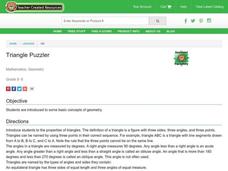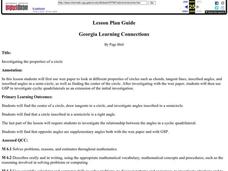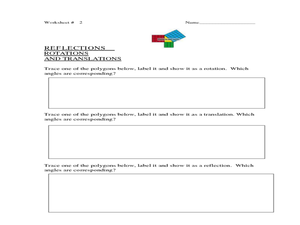Curated OER
Triangle Puzzler
Students are introduced to some basic concepts of geometry. They explain that the definition of a triangle is a figure with three sides, three angles, and three points. Triangles can be named by using three points in their correct sequence.
Curated OER
Classifying and Constructing Corners
Fifth graders, after seeing Honeycomb examples, complete a Classifying Angles worksheet, Clock worksheet, and Defining Angles worksheet.
Curated OER
List of Geometry Terms
In this angle vocabulary card activity set, students identify the vocabulary associated with angles such as: ray, vertex, acute angle, segment bisector, and corresponding angles. They identify 23 terms but there are no questions...
Curated OER
Investigating the properties of a circle
Young scholars use wax paper to look at different properties of circles such as chords, tangent lines, inscribed angles, and inscribed angles in a semi-circle, as well as finding the center of the circle, and use GSP to investigate...
Curated OER
Which Way Do I Go? (Identifying Angles)
Fifth graders practice the concepts related to finding and identifying different angles. There are examples included in the instructional activity that are useful for the teacher to deliver the instructional activity.
Curated OER
Try An Angle
Fifth graders classify the different triangles by sides and angles. They discover how many different ways they can arrange 2, 3, 4 ...7 tangram pieces to create triangles. They classify and label the six triangles on their pattern sheet.
Curated OER
My Test Book: Geometry
In this online interactive math skills worksheet, students solve 10 multiple choice math problems regarding geometry skills. Students may view the correct answers.
Curated OER
2-D Geometry
Third graders describe and compare attributes of two-dimensional shapes. They explain geometric terms, angles and shapes. Students demonstrate each vocabulary word with their body and they mirror the body positions associated with each...
Curated OER
2-D Geometry
Third graders are introduced to new vocabulary related to Geometry. As each word is mentioned, they demonstrate the word with their body. In groups, they identify the similarities and differences between each line and angle. To end...
Curated OER
Points, Lines, Planes, and Space
In this points, lines, planes, and space worksheet, students solve word problems dealing with points, lines, planes, and space. Students complete 20 individual problems and 20 group problems.
Curated OER
Pythagorean Theorem by Graphic Manipulation
There are many different ways to show a proof of the Pythagorean Theorem. Here is a nice hands-on paper cutting activity that shows a graphic representation. You can even challenge your young Pythagoreans to come up with their own...
Dick Blick Art Materials
Start with a Circle...
The Golden Ratio. The Divine Proportion. Yup. It's math and art blended into one colorful activity. Young artists combine colored tissue paper circles and parts of circles to create geometric patterns. As a bonus, kids get to figure out...
Curated OER
Point Comparisons
Young geometers investigate two-dimensional figures using coordinate grids. They identify polygons and draw examples of their reflection, rotation, and translation on a coordinate grid. And they complete a worksheet practicing examples...
Curated OER
Barge Building: What Floats Your Boat?
Students construct aluminum foil boats that float while holding the greatest number of pennies. They investigate the concept of water displacement, record their results, and watch a Bill Nye video on buoyancy.
Curated OER
More Bait for Your Buck!
Learners determine where to buy the heaviest earthworms as they study invertebrates. They create a double bar graph of the results of the weight data.
Curated OER
Human Geometry Book
Students investigate geometric shapes. In this geometry activity, students read the book The Greedy Triangle and define the shapes mentioned in the book. Students make the shapes by using their bodies.
Curated OER
Quilt Squared
Students study West Virginia quilts. In this mathematics lesson, students use symmetry, geometric shapes, and patterns to create their own quilt square.
Curated OER
Triangles
Students identify triangles in the real world and construct their own triangle using drinking straws. They explore abstract triangles and find additional geometric shapes such as trapezoids. Students discuss similar shapes and examine...
Curated OER
Fashion Day
Eighth graders practice using basic measurements to solve word problems.They also investigate finding the perimeter of different polygons and define the characteristics to classify the shape as a polygon.
Curated OER
Problem Solving: Strategy: Use Logical Reasoning
In this problem solving strategy worksheet, 6th graders solve a story problem using the strategies of understand, plan, solve, and look back.
Curated OER
Pythagorean Theorem
Students investigate the concept of the Pythagorean Theorem. After conducting independent practice to find the hypotenuse of a triangle, they work with the teacher using examples in the lesson plan. The direct instruction is delivered...
Curated OER
The Centroid : Balancing the History
Students discover the centroid of a triangle based on Euclid's constructions. They explore locus of points of a median. They understand properties of the segments that form the median and areas of the smaller sections formed by the median.























